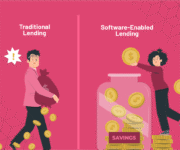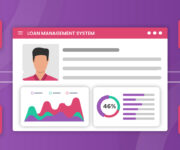The smartphone has transformed banking practices, benefiting consumers and financial institutions (FIs) alike. What was once a complex, time-consuming process of securing a loan has now been reduced to a few taps on a smartphone screen. Therefore, many lenders are increasingly adopting a mobile-first strategy to stay relevant and broaden their customer base.
The numbers tell a compelling story of this digital transformation. As per a Times of India report, digital lending accounted for 1.8% of total retail loans disbursed in FY22 and approximately grew to 2.5% in FY24.
As we explore the factors driving this mobile-first revolution, let us focus on how technology is changing lending and democratising financial access across urban and rural India.
Mobile-First Approach for Digital Lending: An Outline
A mobile-first approach to digital lending means prioritising mobile technology, allowing users to easily handle their credit products through apps, mobile websites, or chat-based platforms, which bring the banks into the user’s pocket.
All in all, a mobile-focused approach helps people become self-reliant and avail of financial services at their convenience, especially in developing nations.
Key Elements of Mobile-First Digital Lending
Now, let us focus on the components and characteristics of being mobile-first in digital lending:
User-Centric Design
Mobile-first lending platforms prioritise intuitive interfaces optimised for small screens. They feature simple navigation and clear calls to action to enhance user experience.
Streamlined Application
The application process is simplified with short forms containing only essential fields. These platforms integrate device features like cameras for document uploads.
Real-Time Decisions
Automated underwriting algorithms enable instant pre-qualification or approval notifications.
Personalisation
Lenders offer tailored loan products, such as customised interest rates and terms to match individual financial profiles.
Seamless Integration
Mobile lending platforms connect seamlessly with digital wallets and payment systems. They also sync with online banking platforms for a comprehensive financial experience.
Enhanced Security
These platforms implement robust security measures, such as biometric authentication and end-to-end encryption, to protect sensitive user data.
Omnichannel Support
Users enjoy a consistent experience across all devices. The ability to switch between devices mid-application ensures flexibility and convenience.
5 Reasons Why the Mobile-First Approach is Redefining Digital Lending in India
Now, let us explore in detail the reasons that are driving this specific transformation:
1. Government’s Focus on Digitisation
The Indian government’s supportive attitude and active promotion of digitisation have created a conducive environment for mobile-based digital lending growth in India.
Some of the major initiatives are:
UPI and Digital Payments
The Unified Payments Interface (UPI), developed by the National Payments Corporation of India (NPCI), has proved to be a great enabler and promoter of instant fund transfer using mobile phones.
The government’s push to promote UPI has reduced dependence on cash and facilitated digital lending using mobiles by allowing lenders to disburse loans directly to borrowers’ bank accounts.
Remote e-KYC
Another aspect that has contributed immensely to enabling digital lending is e-KYC (Know Your Customer). This allows lenders to verify a customer’s identity remotely through facial recognition, Aadhaar-based authentication or document scanning.
BharatNet
The Indian government’s plan to fiberise all villages by 2025 under the BharatNet programme will further boost internet-enabled devices in previously untapped markets.
2. Growth in Smartphone Usage
Mobile phone usage has increased steadily and significantly in India and will continue to do so in the future.
As per a recent report, India will have 1 billion smartphone users by 2026, with rural areas driving the sale of internet-enabled phones.
Higher internet adoption is fueling demand for smartphones, driven by the need to access fintech, e-health, and e-learning services. This growth will drive the popularity of mobile-first digital lending in India.
3. Alternative Credit Scoring Models
The traditional credit scoring method relies only on historical repayment history to assess the applicant’s credit health, often excluding a large population segment.
Fintech startups use alternative credit scoring models, such as social media data, e-commerce transactions, and utility bill payments, to evaluate the creditworthiness of borrowers. This paves the way for financial inclusion and allows the underserved to access credit.
4. Enhanced Customer Experience
Mobile-first digital lending paves the way for better customer experience in the following ways:
Data-Driven Personalised Solutions
Smartphones often generate valuable user data that lenders can use for credit assessment. This includes spending habits, app usage patterns, and even social media activity. Lenders can use AI and machine learning to analyse the data and offer personalised solutions to customers.
Competitive Rates
Lower processing costs when lending through apps allow mobile lending platforms to pass on the benefit to borrowers through lower interest rates and fees, making credit more affordable and accessible.
Faster Approvals
Many mobile lending platforms offer instant pre-approval based on basic information and preliminary checks. Automated processing allows the approval and disbursal process to be completed within hours, providing swift access to funds.
Minimal Documentation
Loan applications via mobiles require minimal documentation, which can be uploaded directly from the applicant’s phone.
5. Mobile-first Digital Lending Also Benefits Lenders
Digital lending through phones offers numerous benefits to lenders as well. Here are the key advantages for lenders:
Reduced Loan Processing Costs
Mobile lending platforms have lower overhead costs compared to traditional setups. For example:
- Lenders do not have to invest in infrastructure or resources to manage their branches in remote areas.
- They can also utilise the existing mobile app to reach customers in the remotest part of the country and increase their customer base.
Scalability
The mobile-first design scales up easily. Expanding from mobile to desktop adds features without compromise, unlike shrinking a desktop application to mobile, which risks losing functionality.
Enhanced Risk Assessment
Mobile platforms build comprehensive borrower profiles by analysing alternative data sources, such as digital footprints, transaction histories, and behavioural patterns, facilitating enhanced risk assessments. Lenders can evaluate the creditworthiness of new-to-credit (NTC) individuals and offer loans to a bigger pool of customers.
In Conclusion
Mobile phones have empowered customers and added immense convenience to everyday lives. With increased smartphone adoption, favourable government policies and changing customer preferences, lenders must focus on a mobile-first approach to maintain their competitive edge and keep customers happy.
Choosing the right solution for a mobile-first digital lending approach is crucial for lenders. Finezza’s mobile app ecosystem allows lenders and customers to leverage the power of smartphones in loan and credit processing. The solution offers the following features:
- Finezza allows verification of KYC documents and acceptance of service requests, detects potential delinquencies, optimises the conversion funnel, and ensures seamless loan servicing through its mobile app.
- The Loan Origination and Loan Management solutions are available via secure APIs for easy integration with existing/legacy systems.
- Lenders can ensure a customer-centric approach to lending.
Contact us now to learn more.




Leave a Reply